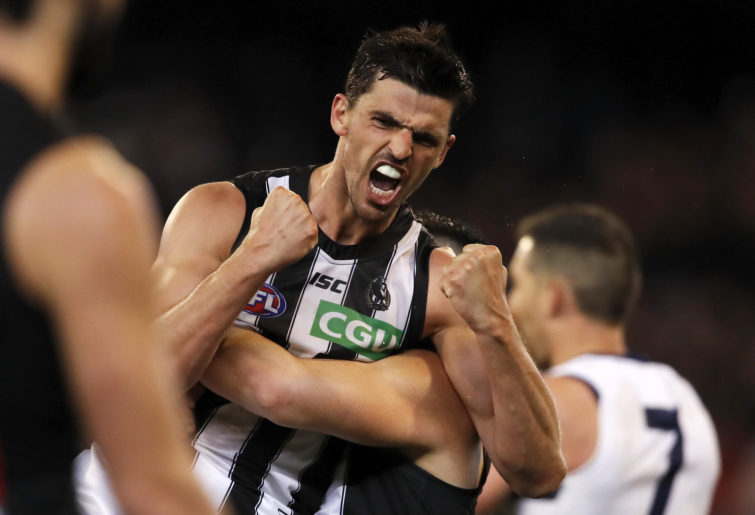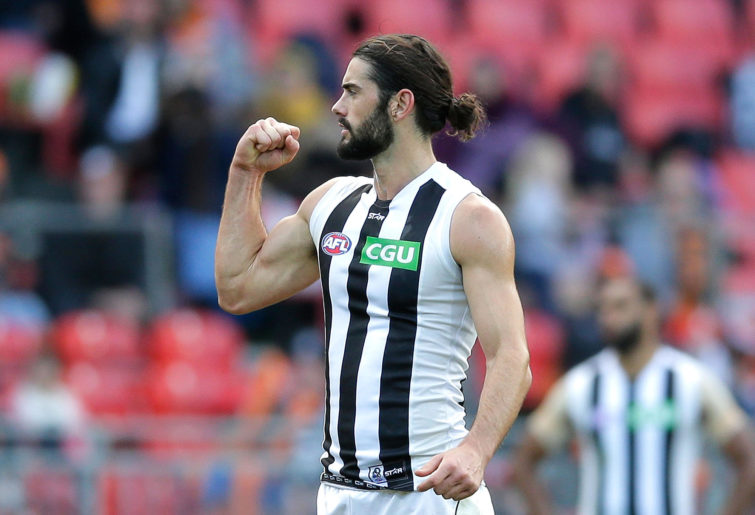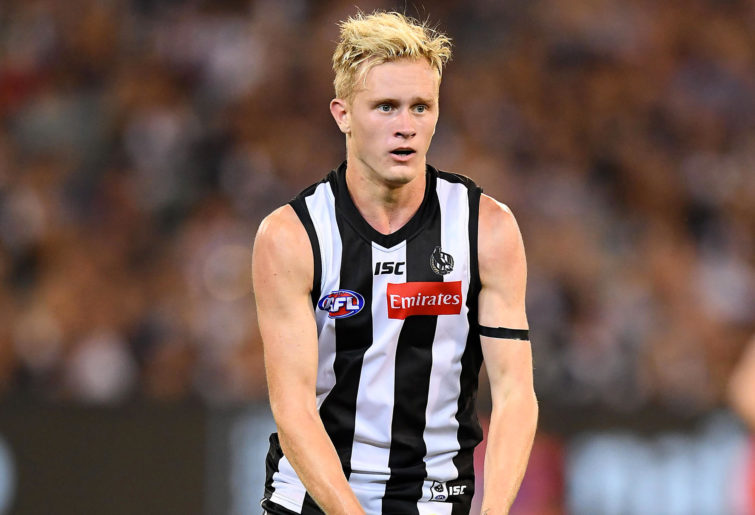AFL News: Scott hits out at 'offensive' Tribunal call to clear Cameron, Pies to swoop on star Dog?
Geelong coach Chris Scott has hit out at the AFL Tribunal's decision to clear Charlie Cameron for his dangerous tackle on Jake Lever, saying…
Opinion
Moving forward, I see five intrinsic issues that constrict Collingwood.
5. Their list is not quite right
As I covered in Part 1, in recent years, Collingwood have had to trade for 30-year-old Lynden Dunn from Melbourne and 28-year-old Jordan Roughead from the Bulldogs to fill key defensive posts. Their two key forwards are an American international rookie (Mason Cox) and a rookie defender (Brody Mihocek).
They’re abundant with flankers, but how many of them would be considered elite? Some are players who’ve been squeezed into new roles due to a dearth of options. For example, Chris Mayne came across as a forward, but was turned into a defensive winger, midfielders Tom Phillips and Josh Thomas have played as half forwards, and run-with midfield Levi Greenwood was turned into a defender.
While the midfield has been vaunted, they have not one single A-grader outside of Scott Pendlebury. Steele Sidebottom, Adam Treloar and Taylor Adams are Bs. The likes of Tom Phillips, Will Hoskin-Elliott and Chris Mayne would rate as Cs. The brains trust would’ve hoped some of these players improved, but they all seem to have hit a plateau.
On Sidebottom, he is consistently rated as elite by punters, but do you seriously place him among truly elite midfield talents such as Dustin Martin and Nat Fyfe? Would you pick Sidebottom ahead of either?
Sidebottom is a very good midfielder (and he could be an elite forward), but to suggest he’s an elite midfielder is stretching it – and an indication that too many players on this list are overrated. This is not to say they’re bad. But they’re not quite as good as many would think.
Jordan de Goey and Jaidyn Stephenson would seem to special talents, but right now their games are highlight reels.

(Photo by Quinn Rooney/Getty Images)
The likes of Josh Daicos, Callum Brown, Tyler Brown and Brayden Sier are promising young players, but are seasons away from revealing how good they’ll become. Will Kelly and last year’s crop of draftees haven’t gotten out there yet.
Brodie Grundy and Darcy Moore are genuinely exciting. I still feel Moore is squandered being a fullback, when he could be the next Jeremy Cameron.
Unlike 2018, where breakout years for De Goey and Sier, and the introduction of Stephenson helped propel Collingwood into a grand final, it’s hard to see where the improvement is going to come from to drive Collingwood beyond what they’ve accomplished in the last two years.
It’s also a concern that their best and most consistent player remains their 32-year-old captain.
4. The balance of the side is wrong
Right now, Collingwood’s side contains Brody Mihocek (44 games), Jaidyn Stephenson (42 games), Callum Brown (39 games), Josh Daicos (21 games), Rupert Wills (17 games), John Noble (nine games) and Tyler Brown (four games) – that’s seven players who’ve played less than 50 games. That’s an inexperienced underbelly that can constitute half the on-field team.
Understandably, unless you’re a talent the calibre of Matt Rowell, as a young player it’s going to take time to develop and to build the physical maturity and psychological composure to consistently mix it at AFL level. Consequently, these players are going to have low-possession games. That’s the nature of development.
When you throw in the likes of Chris Mayne, Will Hoskin-Elliott, Tom Phillips and Mason Cox (and, last week, Steele Sidebottom), who are also capable of returning low-possession games, there’s too much scope for too many players to not get enough of the ball.
While young players have to be blooded and given exposure, what also has to be factored in is where consistent statistical returns are coming from to ensure you’re competitive.
Who can be trusted? Sidebottom has proven he struggles with a tag. Treloar can get big numbers, but question marks remain on his disposal. Adams gets decent numbers and is genuinely proactive. The others are sporadic.
Again, we fall back on Scott Pendlebury.

(Dylan Burns/AFL Photos via Getty Images)
The reason I fall back on Pendlebury is to illustrate an important point in list management: Pendlebury and Dale Thomas were drafted in 2006, and succeeded the likes of Nathan Buckley, Paul Licuria and Scott Burns as the squad’s Grade A mids.
Now, 14 years later, Pendlebury remains that mid, and nobody has succeeded him.
3. On-field adaptability and leadership
Collingwood look great when they’re up and running, as they were against the Western Bulldogs and (in the first half) against St Kilda. They share the ball around and bring players into the game.
But when the pressure hits – as it did against Richmond and GWS – then the system struggles, and teamwork breaks down into individuals struggling to get something started. Now when those individuals are inexperienced, physically immature and easily out-bustled, or low-possession returners, it simply means too much can be left to too few.
I’m unsure who the leaders are meant to be on-field – Scott Pendlebury obviously, and then I’m a big fan of Taylor Adams, who plays with ferocity and is always trying to get something happening. And that’s it. The likes of Grundy, Moore, Jack Crisp and Jordan de Goey should be providing leadership given where they sit in their careers, but it doesn’t happen on the scale required.
I’ll single out Brodie Grundy here as an example: statistically, he demolishes his opponents in the ruck for tap outs. But that still doesn’t translate to midfield clearances. This has been going on since 2018, but was only highlighted following the 2019 preliminary final, yet is still occurring. He’s a brilliant ruck rover, and that’s what makes him unique – the ruck who plays as an extra midfielder.
But as a ruck, he’s primary duty is rucking. Everything else is a bonus.

(Photo by Mark Metcalfe/Getty Images)
How does nobody on the field call in the mids and suggest a change of tactics? Why doesn’t Grundy hammer the ball forward 20 metres as Clark Keating used to do for the Brisbane Lions during their three-peat years? It’s as good as a kick, and immediately unsettles the opposition midfield’s set-up at stoppages. Why do they stick with what’s not working time and time and time again?
Who is providing that intelligence on-field?
It’s galling that this is something that still happens after two years, and it seems the players on-field are banking on systems that have failed them for those two years. Nobody is showing initiative. Nobody is showing leadership. Nobody is saying – even to the coaching staff – that this isn’t working and they need to try something different, or to come up with a series of contingencies.
This leads to the next issue.
2. The coaching brains trust
Nathan Buckley is definitely Mick Malthouse’s apprentice: these are two coaches who planned meticulously, and then arrived on game day and trusted in their systems to see them through. Moves usually were only ever made after the cause was lost.
This is tantamount to talking about all the safety measures the Titanic should’ve had after it hit the iceberg.
Let’s take last week’s game against Greater Western Sydney as an example.
• In a move that didn’t surprise a single Collingwood supporter, Greater Western Sydney brought back Shane Mumford to compete with Brodie Grundy.
• Tagger Matt de Boer went to Steele Sidebottom. In the first half, De Boer completely shut Sidebottom out of the game. Sidebottom got more of it in the second half, but was far from influential.
• Toby Greene got the better of Brayden Maynard and was best on ground.
• Zac Williams – until he did his hamstring – was the architect of so many GWS attacks.
And Collingwood’s response to these tactical initiatives?
Nothing. To all of them.

(Photo by Ryan Pierse/Getty Images)
Why would the game change in favour of Collingwood if strategic assaults aren’t countered? Because the systems have worked in the past? GWS had beaten Collingwood in four of their last five meetings – this was their fifth in six games. So those systems can’t be trusted. Definition of insanity and all that.
Collingwood only got back into the game against GWS not because they out-played or out-strategised GWS, but because Zac Williams and Phil Davis (minding Mason Cox) went off injured.
Why not try something tactically? Why not start Mason Cox in the ruck for the first seven minutes and tell him to run Mumford around, and then bring Grundy in as the fresher alternative? Why not swing Maynard into the middle and put Hoskin-Elliott – who was also struggling – back on Greene? Why not move Sidebottom to full forward? Why not sit Tom Phillips on Zac Williams with the instructions of a hard tag?
I understand when things are working that it’s a danger to change them. But in this instance, Grundy was struggling for ruck efficiency, and Hoskin-Elliott and Sidebottom were ineffectual. Maynard was getting the ball, but struggling defensively. What was there to lose by trying something different? What was there to lose by being proactive?
Talking to a number of Collingwood punters, one of their biggest concerns about the incumbent coaching staff is how tactically stoic they are.
Flags are won by teams who take chances, rather than those who play it safe.
Given the coaching staff’s attitude seems so stodgy, why would the players showcase any initiative themselves?
If the coaching staff are instructing their charges to be audacious, either something is being lost in the translation, or the systems aren’t consistently holding up on-field.
1. The unraveling game plan
When Collingwood are able to get their running game going – again, as they did against the Bulldogs and Saints – they look great. But when they become blocked up, they resort to trying to chip their way through traffic, only for skill errors to see it undone, or they go for the long chaos ball, hoping to crumb spillage.
Both options become self-defeating. As far as the chipping goes, the slower they move the ball, the tighter opposition apply their zones. The tighter the zones, the more Collingwood slow down. Ball movement becomes stagnant. So then it’s a long kick and a hope for the best.
Now if this was still Collingwood who had the likes of Anthony Rocca and Travis Cloke – two contested marking beasts – it might work as a Hail Mary, rather than a constant fallback. But they’re often relying on Mason Cox, which becomes one-dimensional.
While the likes of Stephenson and De Goey can rove, Collingwood lack genuine crumbers – such as Leon Davis and Alan Didak and Andrew Krakouer – who can capitalise on spillage.

(Photo by Quinn Rooney/Getty Images)
What Collingwood miss during these occasions is initiative. The problem is the list build doesn’t provide those options. Taylor Adams tries – he will just about always try to make something happen. Jack Crisp can occasionally do it from half back. Jordan de Goey and Jaidyn Stephen may get there. But that’s a lot of ifs and maybes. Who else does it now?
Adam Treloar is an option, but too often last year got caught on the inside. His asset should be his line-breaking pace, but instead he’s sitting at the coal face, waiting to provide a dinky handball out or a quick snap around the body to clear the ball.
This is surely not the best way to use Treloar, and reduces him to a plodding inside midfielder. Is that what Collingwood wanted when they spent two first round draft picks on him?
It’s imperative that Collingwood get some big-bodied mids who play this as their natural game – which is why somebody like Rupert Wills is important, and they desperately need Brayden Sier to recapture his 2018 form and build on that. Players such as Adams, Sier and Wills allow midfielders such as Pendlebury, Sidebottom, Treloar and Phillips to sit on the outside and employ their unique skills to construct offensive – skills that would see them far more effective than they’re being employed now.
As it is, the side lacks genuine synergy due to the way the list has been manufactured, and when things aren’t working they seem to neither have the fallback, or the off-field or on-field initiative to change it up or make something happen – or to at least try.
Too often Collingwood’s best and only form of attack is desperation and intensity, and as has been proven repeatedly over the last two and a half years, that will only get them so far.